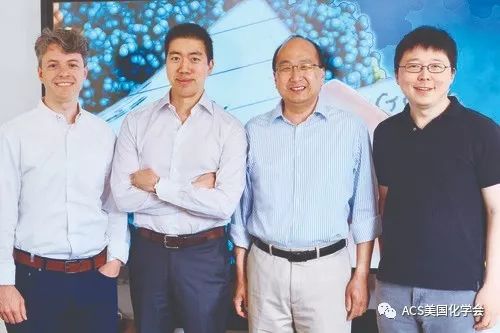基因编辑初创公司Beam获得融资8700万美元
| 导读 | 初创公司Beam将基于David Liu 的CRISPR基因编辑技术开展治疗 |
Beam launches for base editing
by Ryan Cross for C&EN
初创公司Beam将基于David Liu 的CRISPR基因编辑技术开展治疗

Beam CEO John Evans and the firm’s three cofounders: David Liu, Keith Joung, and Feng Zhang.
Beam首席执行官John Evans和该公司的三位创始人:David Liu,Keith Joung和张锋。
(Credit: Beam Therapeutics)
这将成为CRISPR基因编辑充满现金流的又一年。在过去两个月,有四家公司因为新发现或CRISPR的新设计版本而开始运行。
在所有企业中,由麻省理工学院和哈佛大学博德研究所David R. Liu的实验室开发的碱基编辑可能最令人兴奋。当然,他们也吸引了很多的资金。
就在两年前,David Liu首次推出了他实验室的第一代碱基编辑,可以使DNA中的单核苷酸碱基改变。自那以后,碱基编辑和高级迭代一起,已经被全球研究实验室共享了3000多次。它们被用于编辑细菌、真菌、植物、昆虫、鱼类、小鼠甚至人类胚胎的DNA。
在这项技术急速发展的过程中,David Liu已经悄悄地成立了一家公司,致力于将碱基编辑转化为遗传疾病治疗。初创公司Beam Therapeutics在上周推出了由F-Prime Capital Partners和Arch Venture Partners牵头的A轮融资,总计高达8700万美元。
Beam并不是David Liu的第一家CRISPR公司。David Liu的碱基编辑也是Pairwise Plants的奠基者,该公司在3月份开始运行,致力于开发基因编辑作物。他还和张锋(博德CRISPR基因编辑发明人)及J. Keith Joung (麻省总医院和哈佛医学院基因编辑研究员)一起是CRISPR一家原创公司Editas Medicine的联合创始人。
事实上,张锋和Joung也加入了David Liu的公司,成为Pairwise Plants和Beam的联合创始人。David Liu说:“志同道合的人走到一起,是很自然的事情。”
Editas致力于在传统CRISPR基因编辑形式上,使用称为Cas9的酶在DNA中进行特定切割。Cas9被David Liu比作为一对分子剪刀,对于删除和破坏基因非常有用。
但是该技术不能将DNA的单个碱基或字母(A,T,G或C)替换为另一个碱基。凭借蛋白质工程技术,David Liu和他的学生们创造了CRISPR的新版本 - 他们称之为碱基编辑– 碱基编辑能够做到将DNA的单个碱基或字母替换为另一个碱基。
David Liu的第一个碱基编辑可以将C转换为T,将G转换为A。他的第二个模型可以将A转换为G,将T转换为C。据某个数据库的信息,有33,000个单字母DNA突变与疾病有关。David Liu的碱基编辑可以做出的四项改变假设能够纠正63%的DNA突变。“对于某些应用,剪刀是最好的工具,”David Liu解释说。“但如果目标是简单地修复单点突变,那么碱基编辑确实是最好的工具。”
除了从哈佛获得David Liu的碱基编辑许可外,Beam还获得在张锋的实验室开发、被称为REPAIR的碱基编辑系统的许可。REPAIR能够在mRNA中将A变为G (DNA和蛋白间的短暂中间码)。虽然David Liu的碱基编辑有利于进行永久性改变,但REPAIR可以进行瞬态处理,因为细胞会不断产生新的mRNA。
将这些研究工具转变为疗法还面临许多挑战,包括将大型碱基编辑复合物传输到受疾病影响的细胞中。但Beam不必从头开始。“我认为其他公司在这个领域奠定的基础确实会帮助我们更快地发展,”Beam的首席执行官和Agios前高管John Evans说。
Beam并没有透露他们希望治疗哪些疾病,但David Liu说,该公司已经启动了10到15个探索不同靶标的项目。碱基编辑还可以更易于处理其他公司用Cas9基因编辑处理的疾病。
Evans说:“显然,我们手里有资源,可以同时做很多事情。因此你可以预期从我们这里得到广阔的渠道。”
Beam现在有15名员工,包括来自联合创始人实验室的几名已毕业的学生。“这证明了我们都对这些技术怀有激情,”David Liu说。“我们想确保科学最终以广泛而有意义的方式使社会受益。”
It’s shaping up to be another year full of cash flowing for CRISPR gene editing. In just the past two months, four companies have launched based on newly discovered or designed versions of CRISPR.
Of all those variants, the base editors developed by David R. Liu’s lab at the Broad Institute of MIT & Harvard might be causing the most excitement. They’ve certainly brought in the most money.
Just two years ago, Liu debuted his lab’s first base editors, which can make single nucleotide base changes in DNA. Since then, those base editors, along with advanced iterations, have been shared with research labs worldwide more than 3,000 times. They’ve been used to edit DNA of bacteria, fungi, plants, insects, fish, mice, and even human embryos.
Amid that whirlwind of development, Liu has been quietly building a company that will try to transform the base editors into treatments for genetic diseases. That start-up, Beam Therapeutics, launched last week with up to $87 million in series A funding led by F-Prime Capital Partners and Arch Venture Partners.
Beam isn’t Liu’s first CRISPR company. Liu’s base editors are also the foundation of Pairwise Plants, which launched in March to develop gene-edited crops. He was also a cofounder of one of the original CRISPR companies, Editas Medicine, along with Feng Zhang, an inventor of CRISPR gene editing at Broad, and J. Keith Joung, a gene-editing researcher at Massachusetts General Hospital and Harvard Medical School.
In fact, Zhang and Joung are joining Liu as cofounders of Pairwise Plants and Beam too. “It was really a natural fit to keep the band together,” Liu says.
Editas is largely focused on a traditional form of CRISPR gene editing that uses an enzyme called Cas9 to make specific cuts in DNA. Cas9, which Liu likens to a pair of molecular scissors, is useful for deleting and disrupting genes.
But the technique can’t swap a single base, or letter—A, T, G, or C—of DNA for another. Through a feat of protein engineering, Liu and his students created new versions of CRISPR—what they call base editors—that do just that.
Liu’s first base editor can convert C to T and G to A. His second model can convert A to G and T to C. According to one database, 33,000 single-letter DNA mutations are associated with disease. The four changes that Liu’s base editors can make could hypothetically correct 63% of them. “For some applications, scissors are the best tools,” Liu explains. “But if the goal is to simply fix a single-point mutation, base editing is really the best tool.”
In addition to licensing Liu’s base editors from Harvard, Beam may also license a base-editing system developed in Zhang’s lab called REPAIR that makes an A-to-G change in mRNA, the short-lived intermediate code between DNA and proteins. While Liu’s base editors are good for making permanent changes, REPAIR could be used as a transient treatment, because cells continually generate new mRNA.
Many challenges lie ahead for turning these research tools into therapeutics, including delivering the large base-editing complexes into cells affected by a disease. But Beam doesn’t have to start from scratch. “I think the foundation that’s been laid by other companies in this field will really help us go faster,” says John Evans, Beam’s CEO and a former executive at Agios.
Beam isn’t disclosing what diseases it hopes to treat, but Liu says the company has already launched 10 to 15 programs exploring different targets. Base editing could also allow it to more easily tackle diseases that other companies are already working on with Cas9-based gene editing.
“We obviously have the resources in hand to do many things in parallel,” Evans says. “So you can expect a very broad pipeline from us.”
Beam has 15 employees now, including several former students from the cofounders’ labs. “That is a testament to the passion that we all feel for these technologies,” Liu says. “We want to make sure the science actually ends up benefiting society in a broad and meaningful way.”
This article is reproduced with permission from Chemical & Engineering News (© American Chemical Society). The article was first published on May 21, 2018.
(转化医学网360zhyx.com)
 腾讯登录
腾讯登录
还没有人评论,赶快抢个沙发